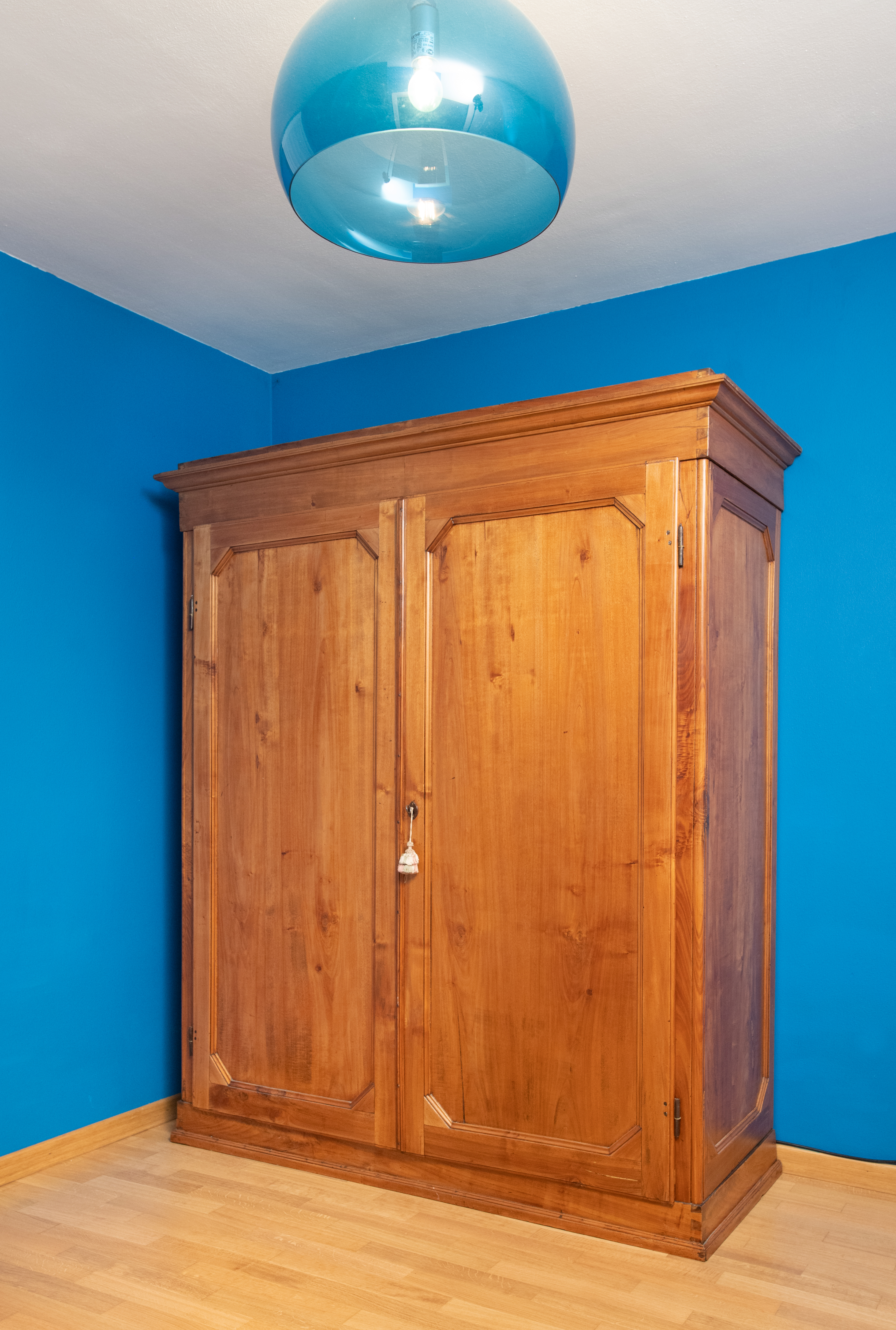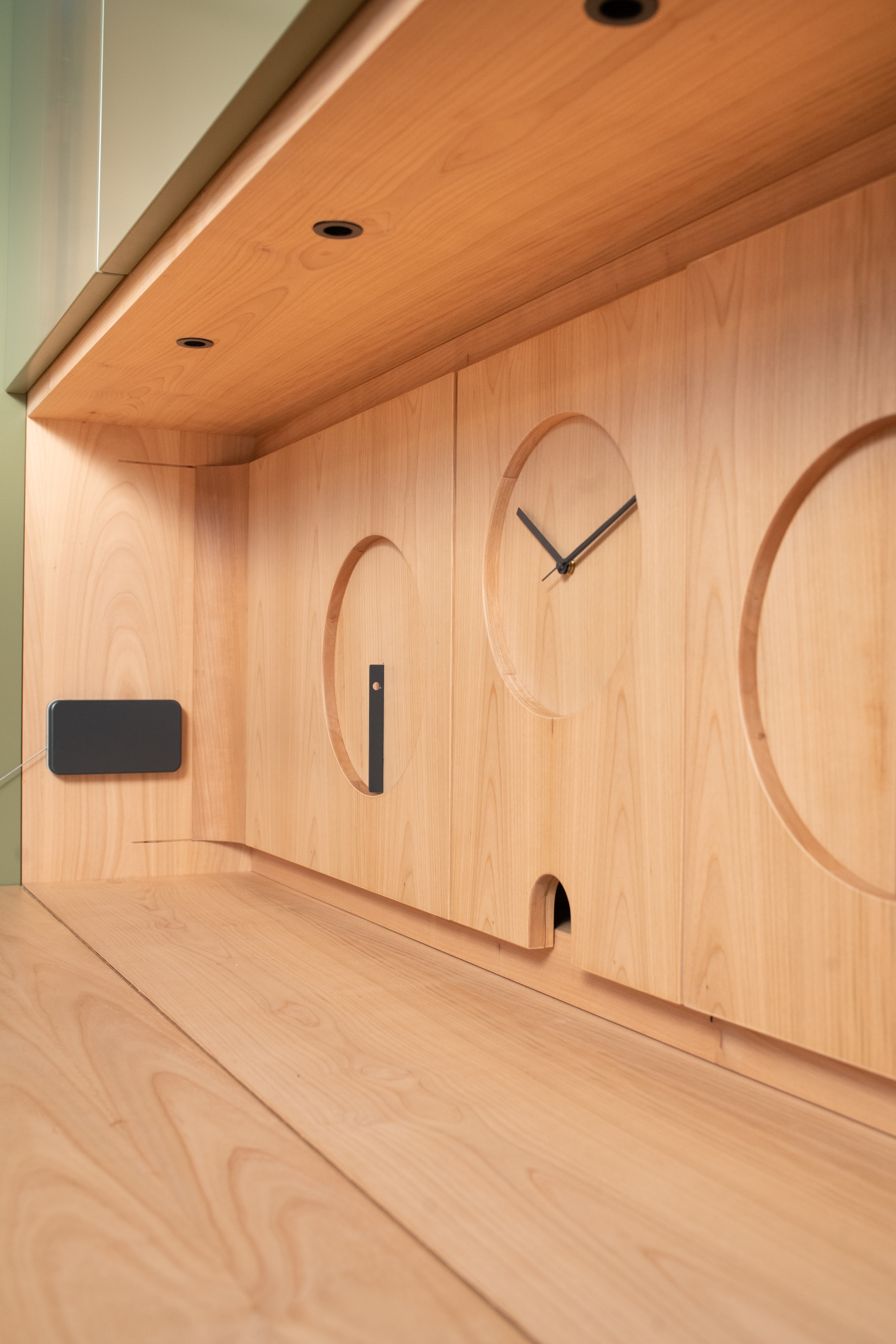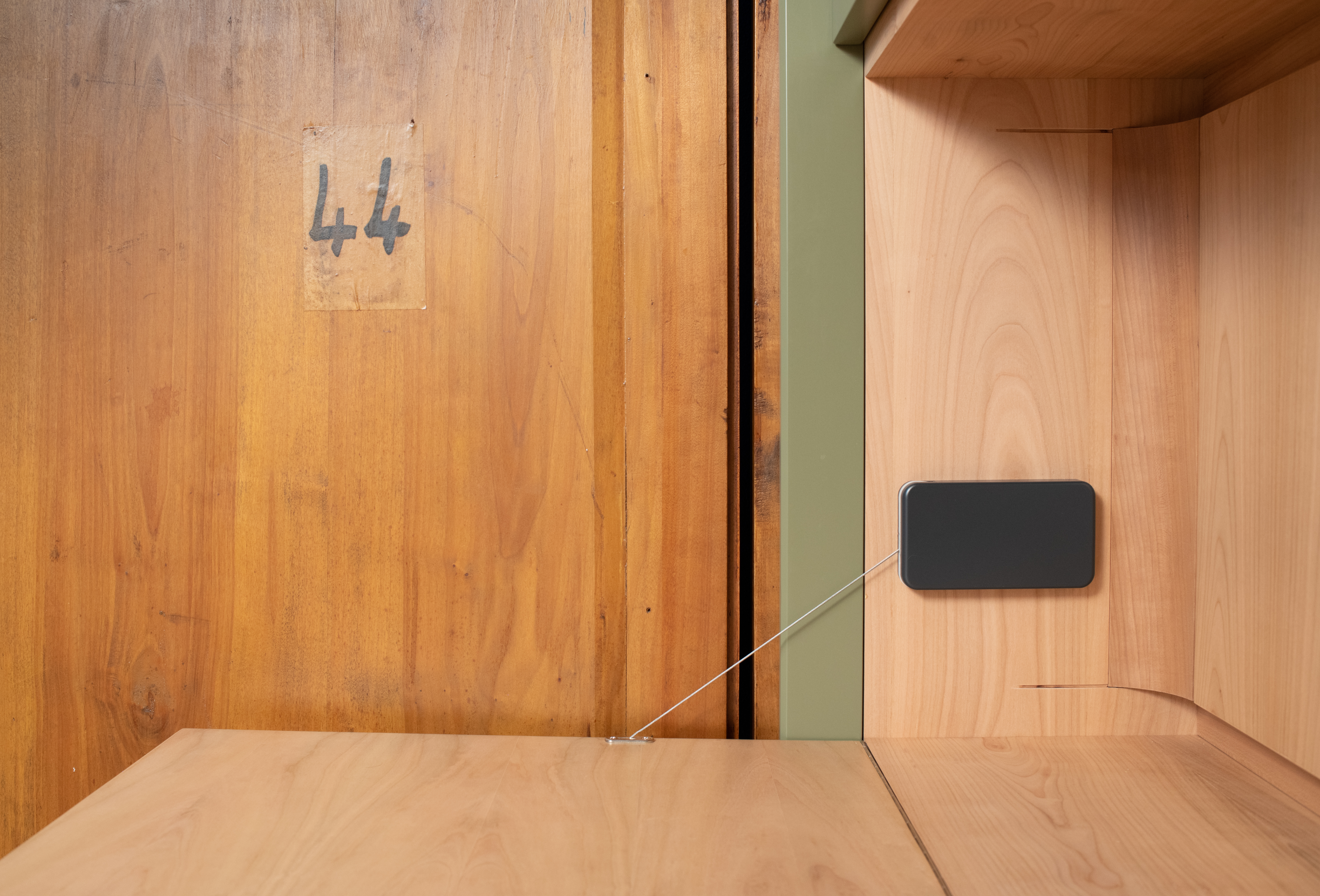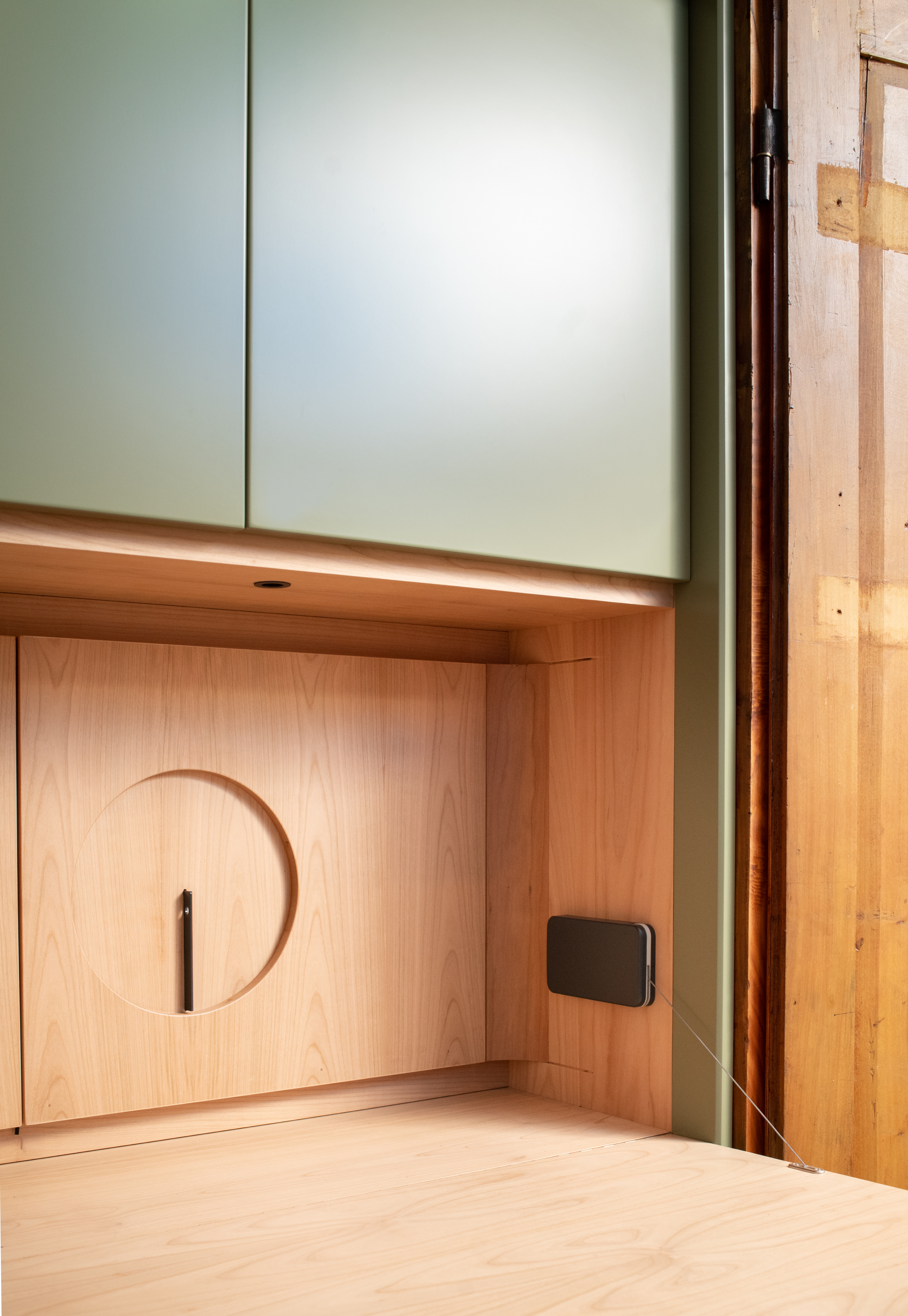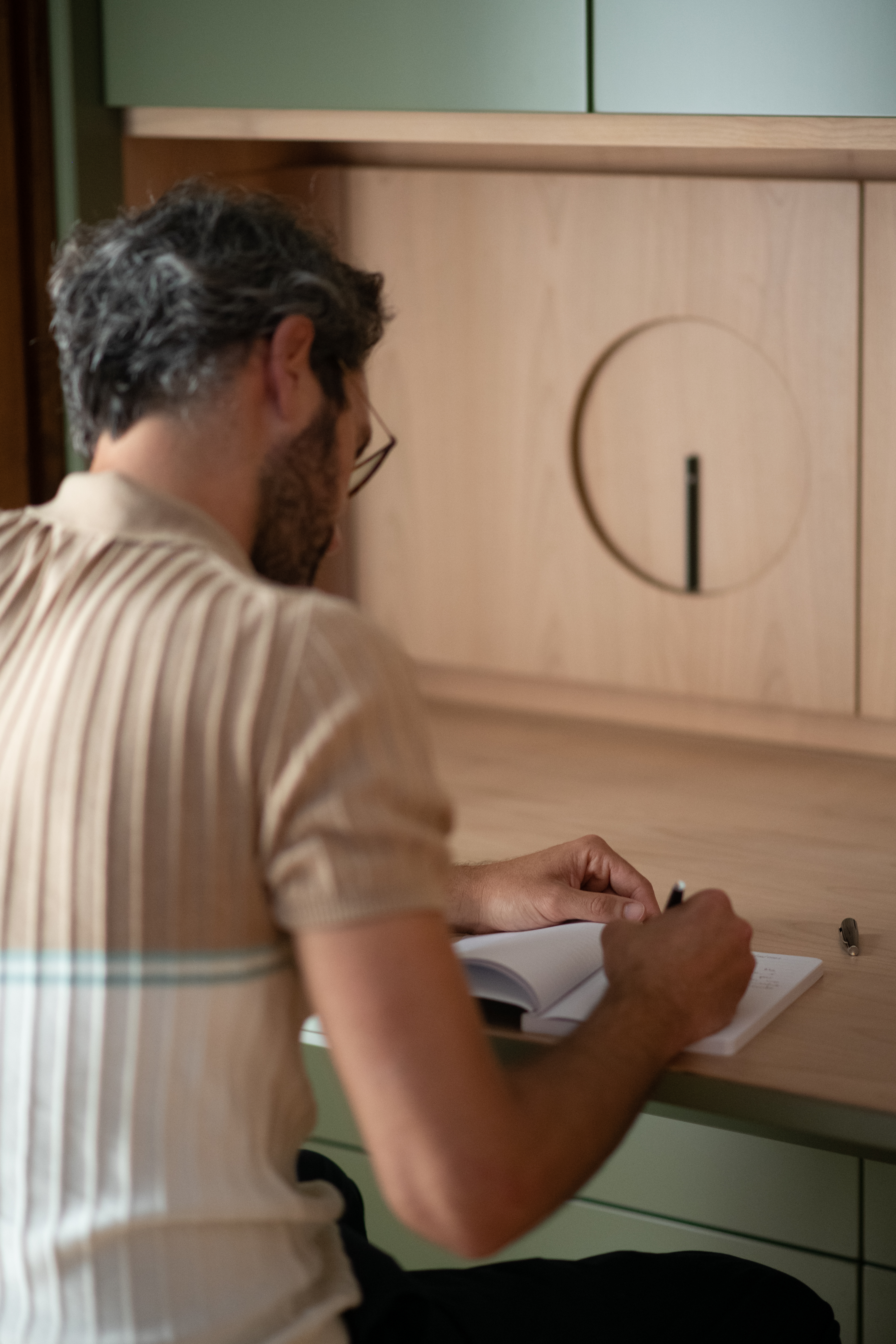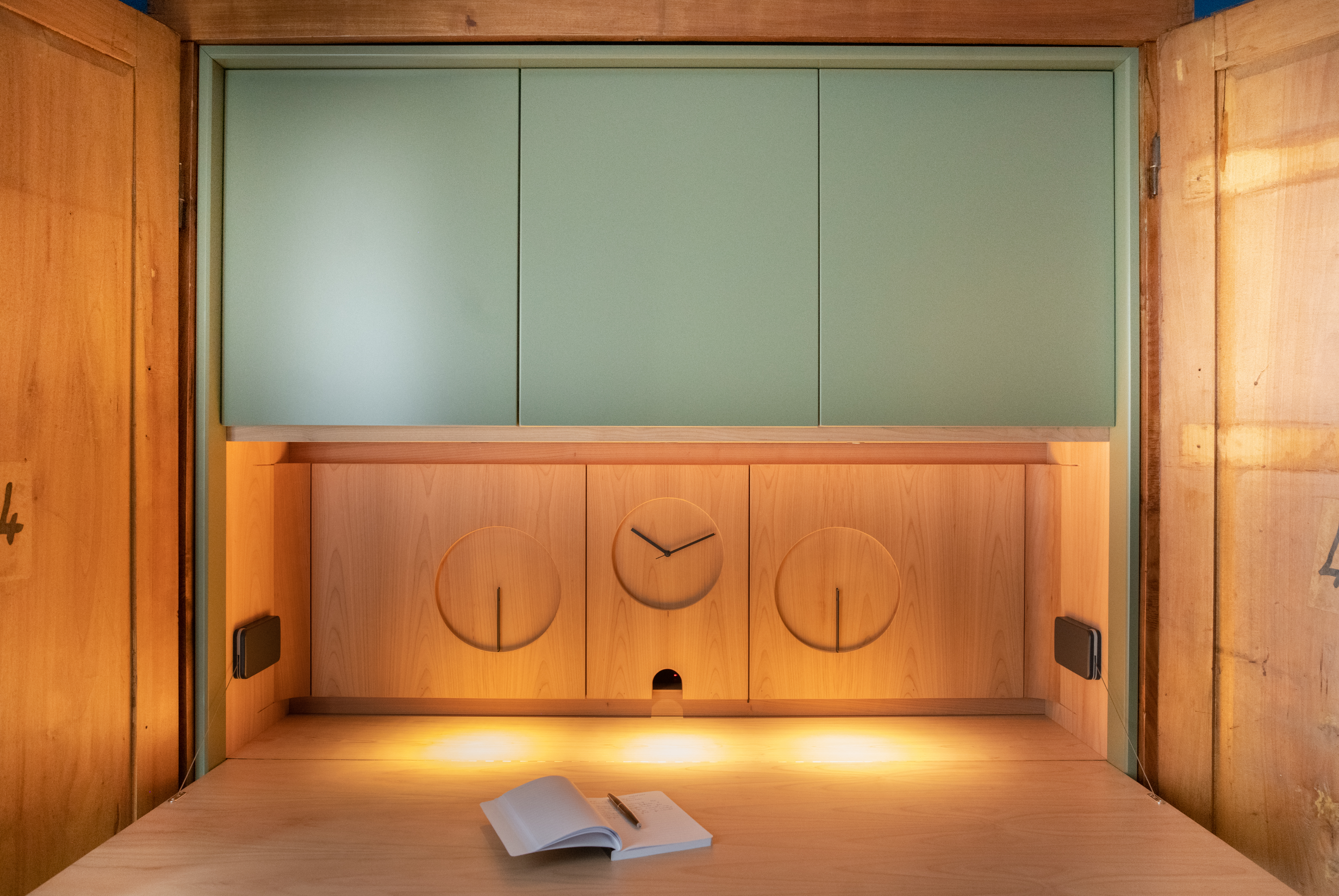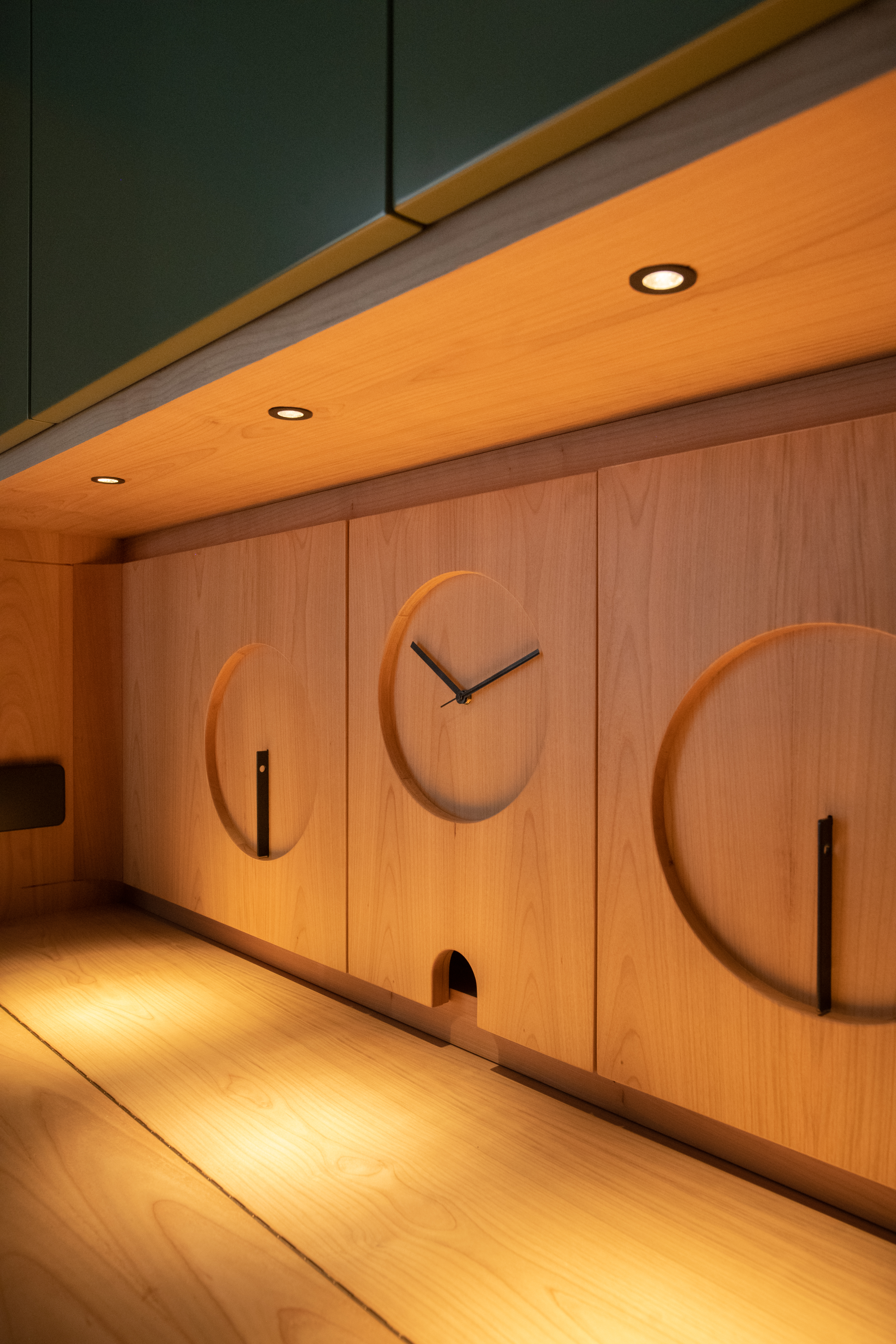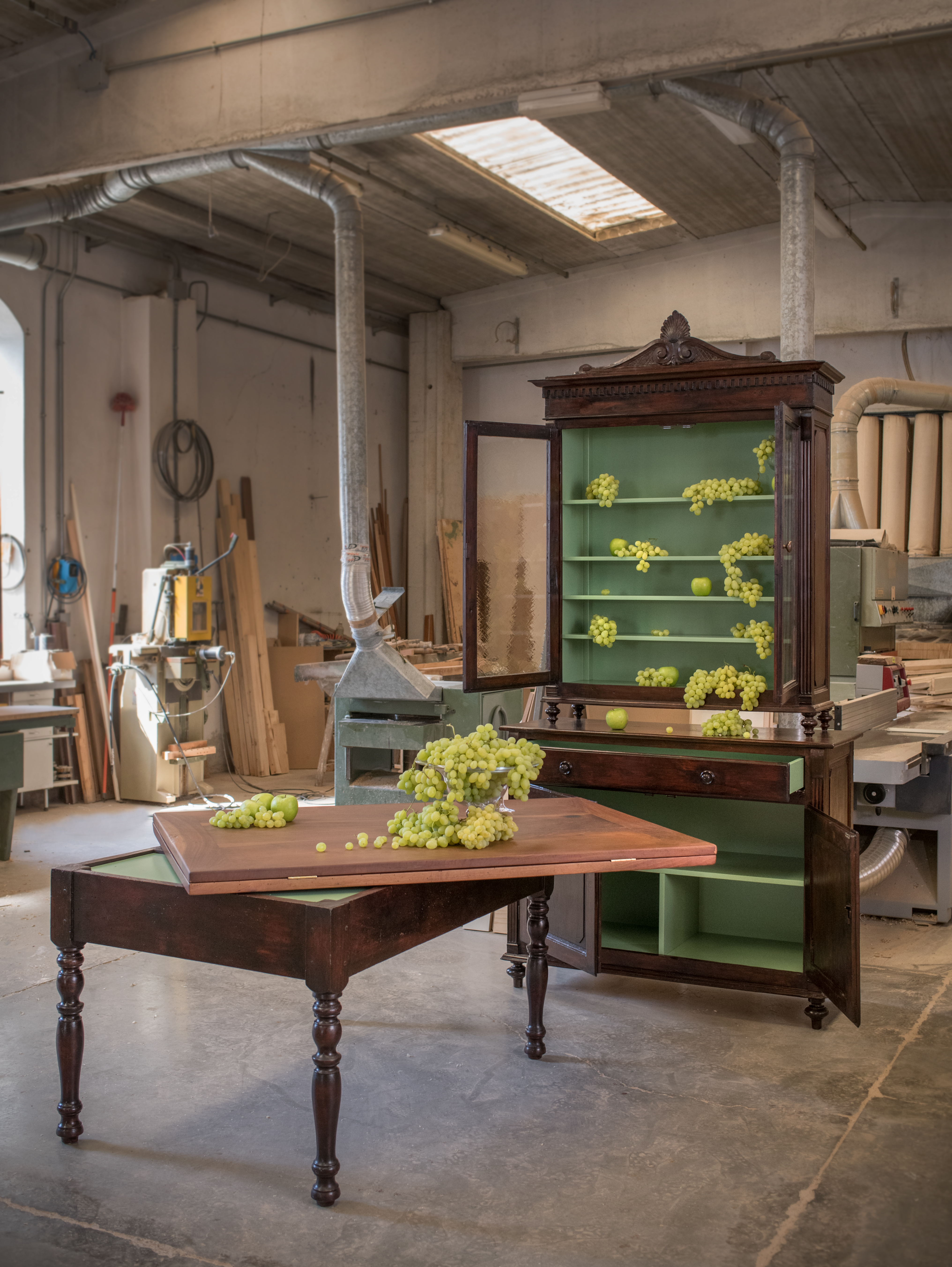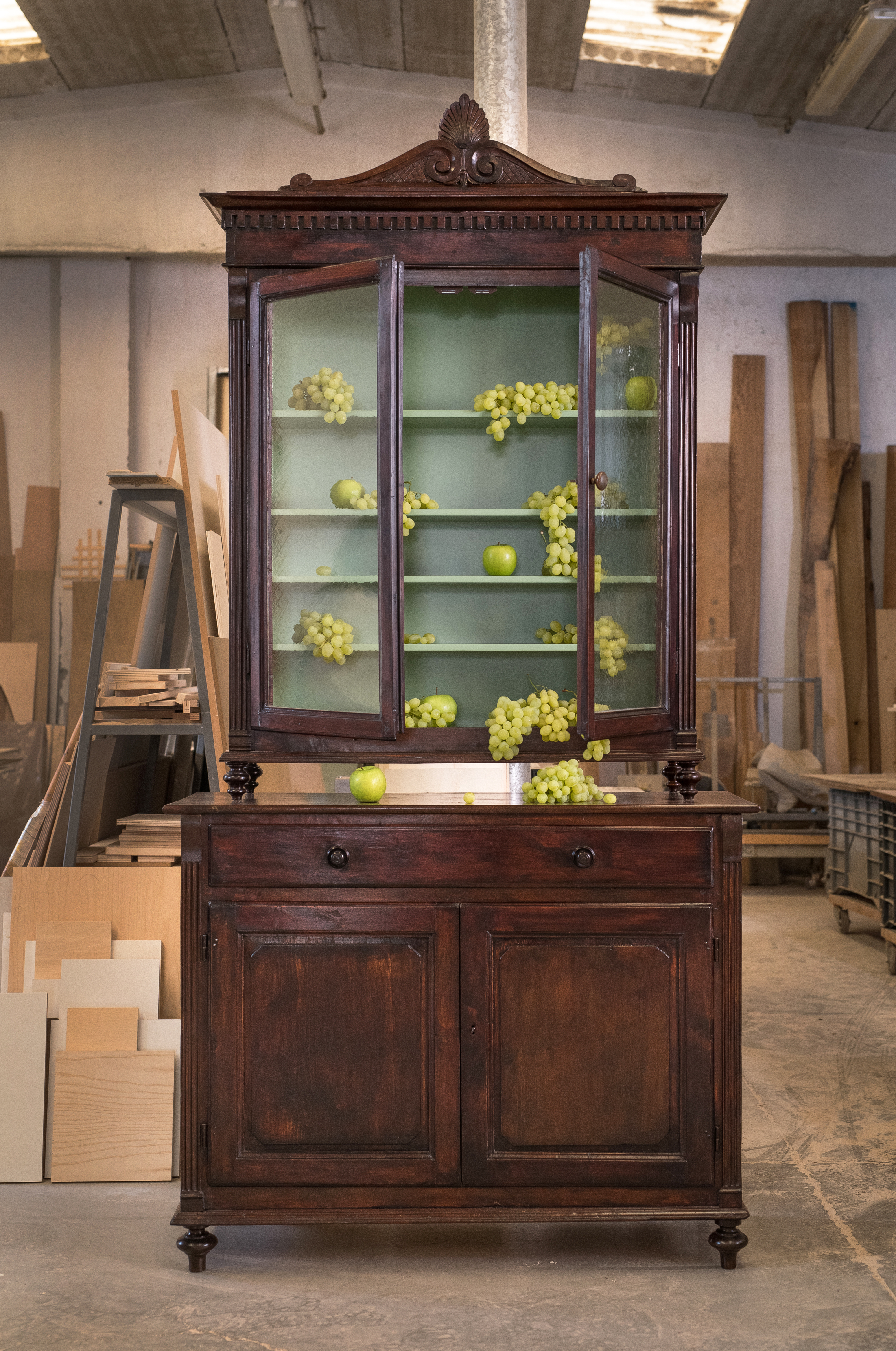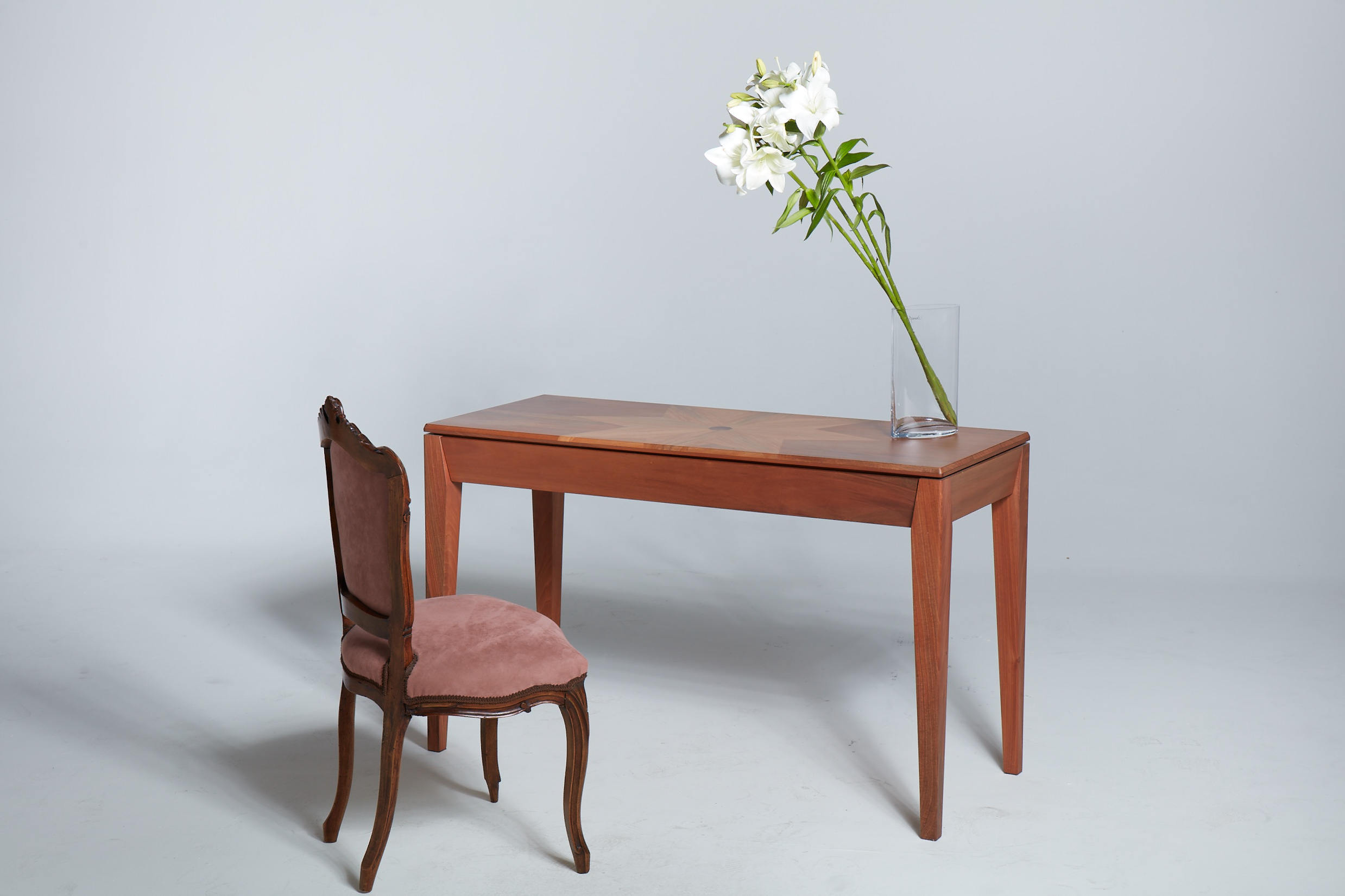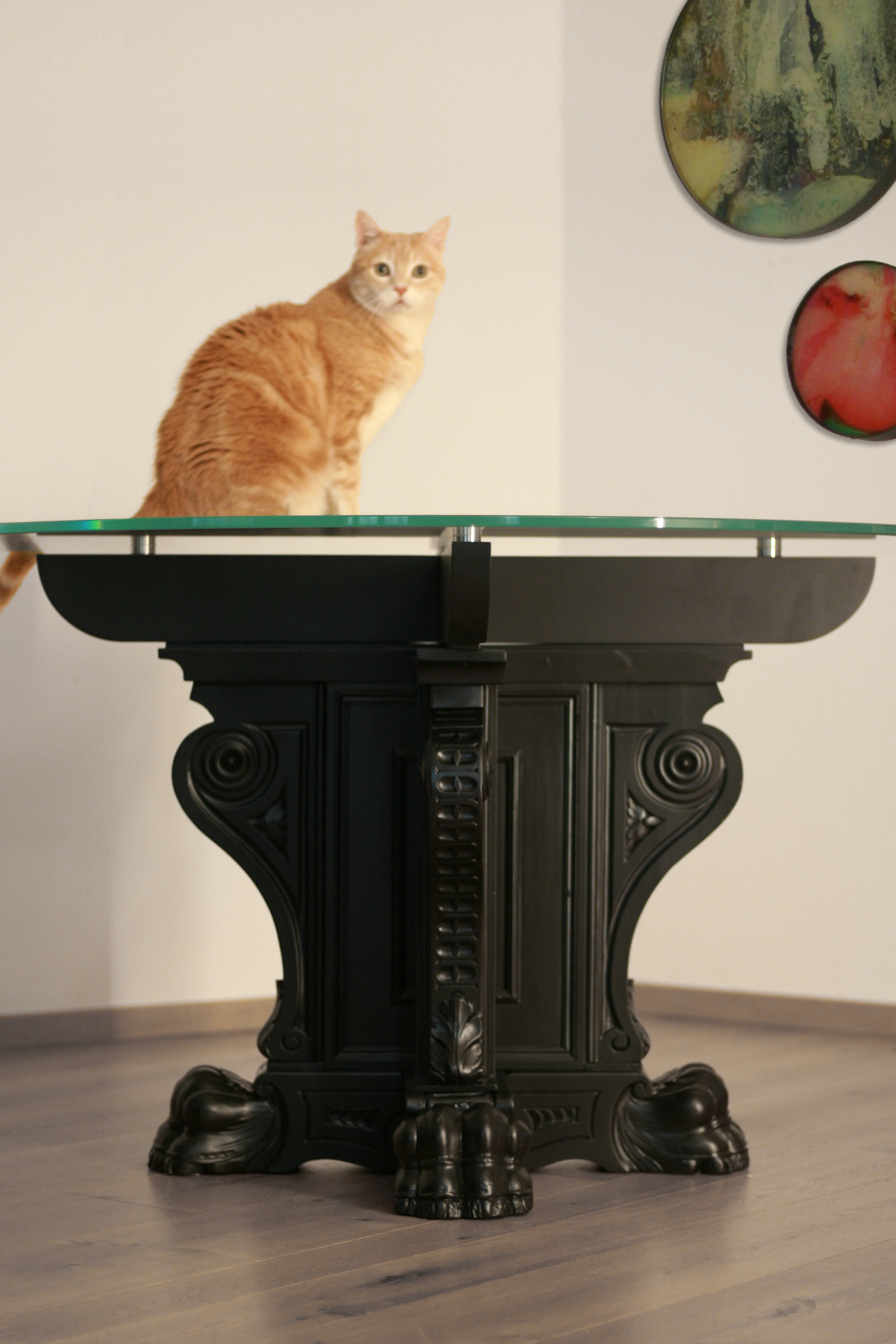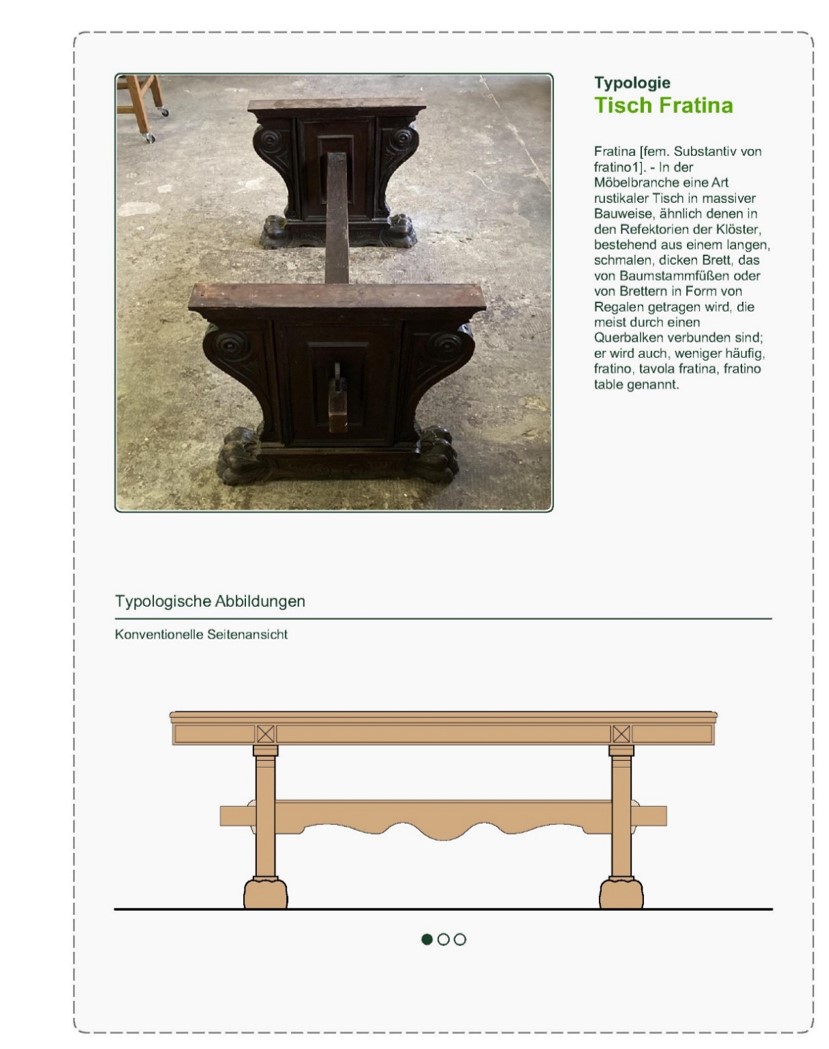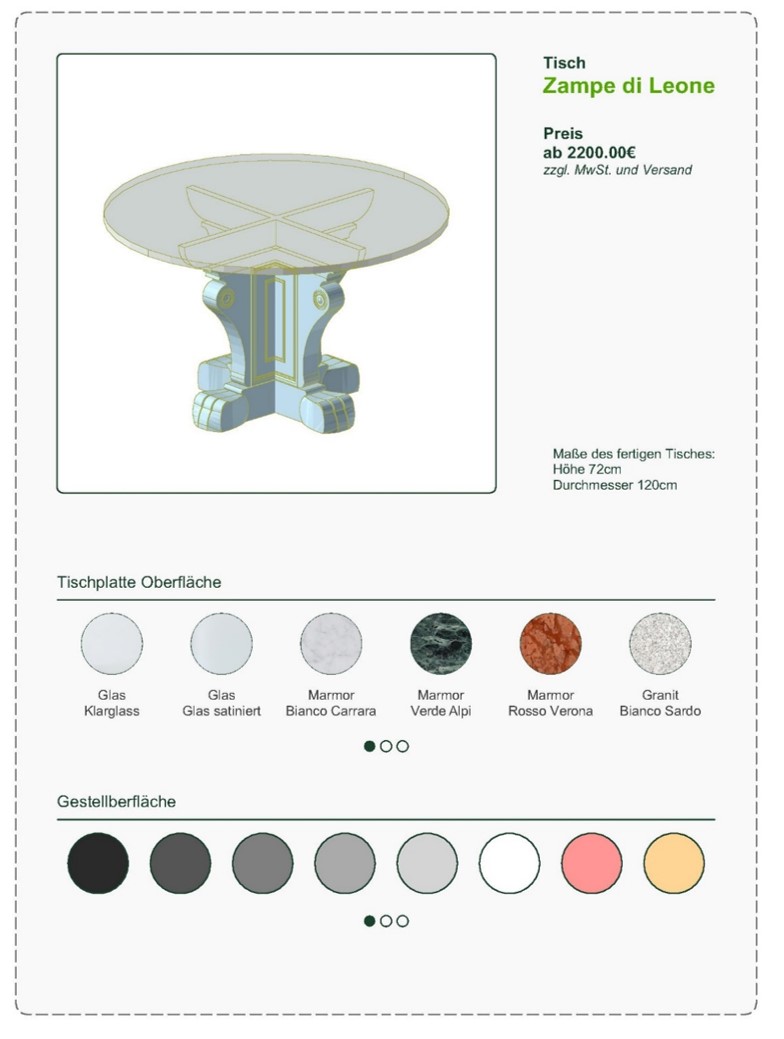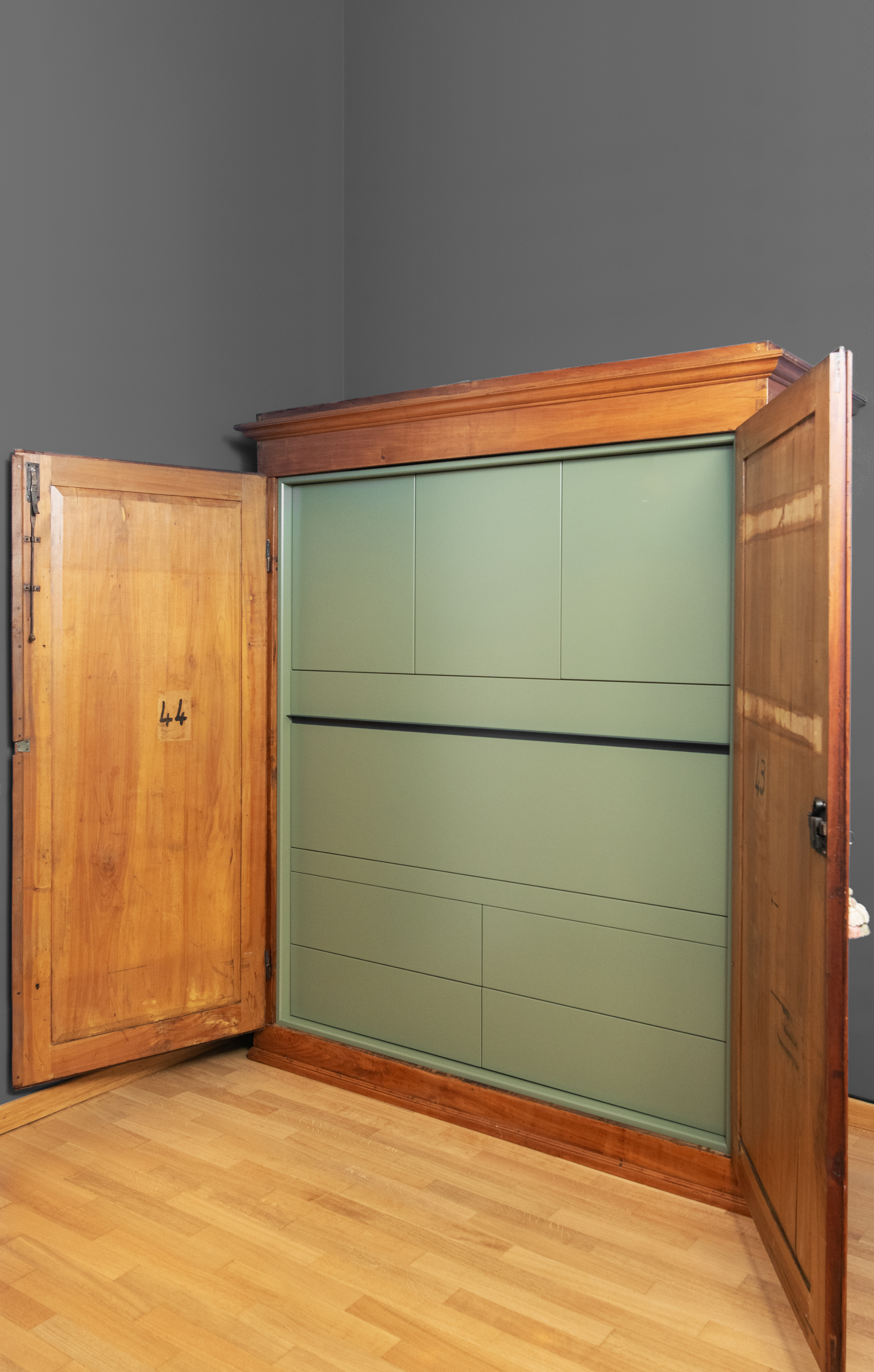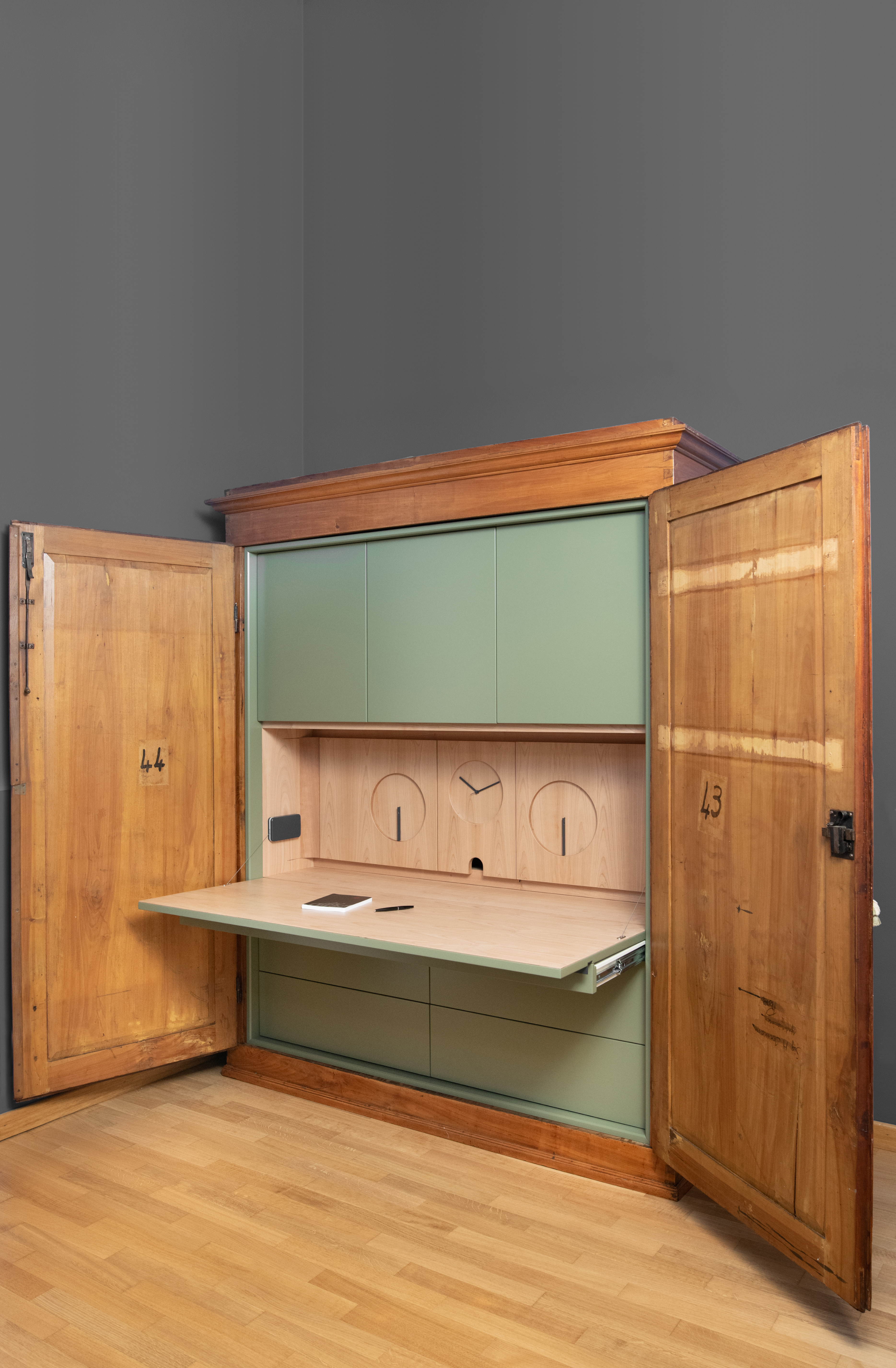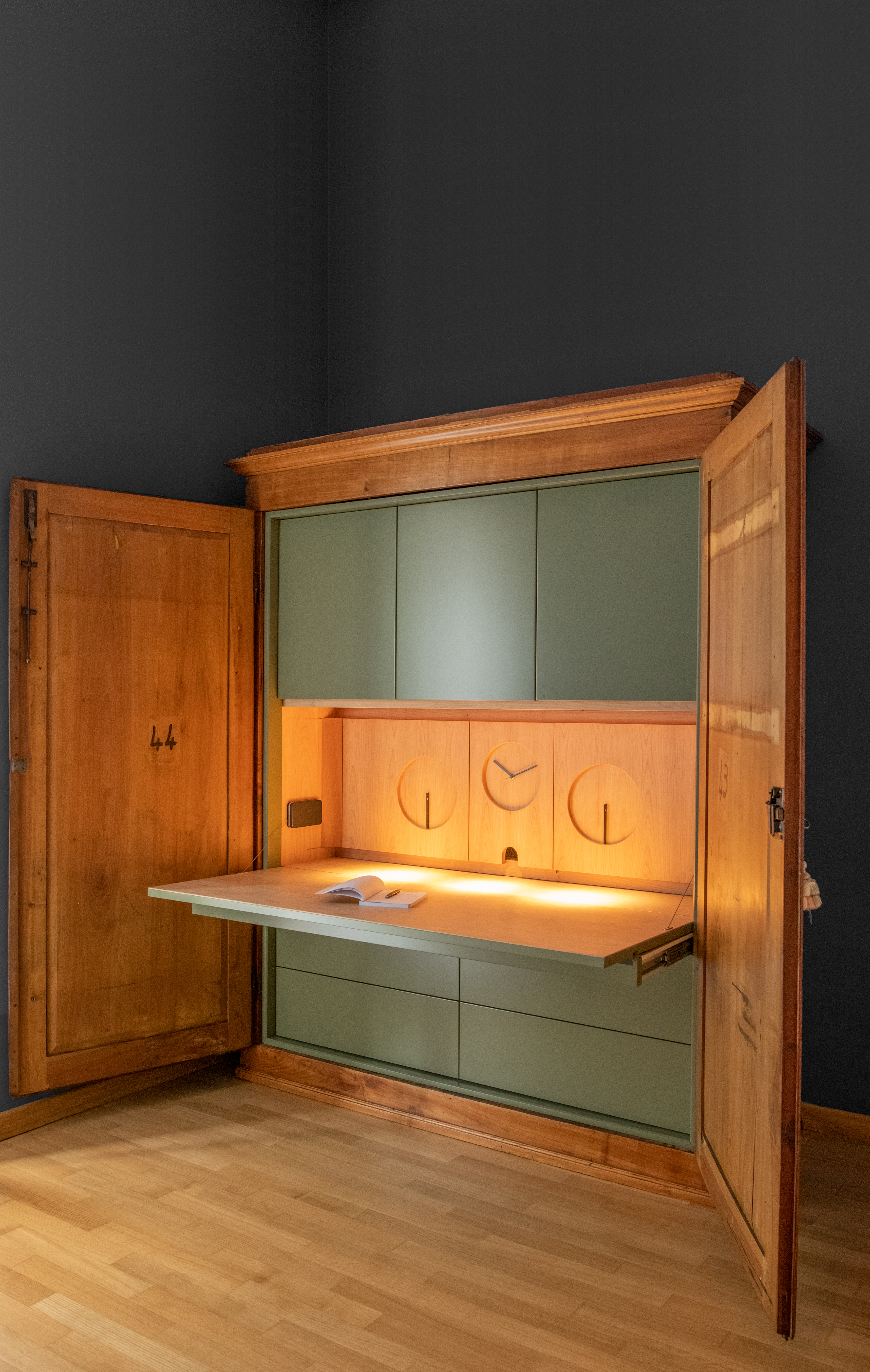Regaining a sense of belonging
Contemporary design for old furniture
A proposal for the preservation of local historical heritage in the context of design projects.
Our mission is to rethink traditional furniture, modernise it and return it to the cycle of use as customised designer objects. We have redesigned an old wooden cabinet to create modern home-office furniture. This approach, applied on a larger scale, offers numerous benefits: it supports generational dialogue, preserves local culture and traditions, and employs artisans and designers. Furthermore, it creates chances for young creatives to develop a sustainable, shared and individualised future.
Italy
Local
Region of Pisa
It addresses urban-rural linkages
It refers to a physical transformation of the built environment (hard investment)
Yes
2017-10-01
No
No
No
As a representative of an organisation
The problem identified by the European Environmental Bureau reports that EU companies and consumers discard 90% of their furniture every year and despite the high quality of some materials and the intrinsic value of used furniture, the restoration offer remains very limited, at around 6%.
At arkitettoria, we aim to rethink used furniture, modernise it and return it to the cycle of use as individual designer furniture. The approach we use is to transfer the principles of architecture into design. Here is a case study, the Romeo wardrobe. First, we try to place the object in space. A large piece of furniture designed for country houses in the late 19th century is cumbersome in modern flats with small rooms and lower ceilings. Thus it is necessary to think of the cupboard as a room, a small room, e.g. for work, home office. This use is more contemporary than ever, given the growing popularity of the New Work trend in Europe.
For the exterior part, we use a conservative approach; the precious cherry wood, a century old, is carefully restored and preserved in its entirety. In contrast, we use a reconstruction and replacement approach for the interior part, which is less valuable and ruined by time and daily use. This must not only fully recover its functionality, but also be brought up to date with the contemporary state of the art through the use of lightweight composite materials, hinges, internal lighting, USB connections for computers and finally a clock. In the end, with a careful choice of colours and finishes we compare the new and the old, seeking aesthetic balance.
Data: 125 working hours, cost approx. 6000 Euro, considering that the wardrobe itself was already in the possession of the customer. The work was carried out in Italy in 2020. We hope that the wardrobe could stay in use for the next 100 years.
At arkitettoria, we aim to rethink used furniture, modernise it and return it to the cycle of use as individual designer furniture. The approach we use is to transfer the principles of architecture into design. Here is a case study, the Romeo wardrobe. First, we try to place the object in space. A large piece of furniture designed for country houses in the late 19th century is cumbersome in modern flats with small rooms and lower ceilings. Thus it is necessary to think of the cupboard as a room, a small room, e.g. for work, home office. This use is more contemporary than ever, given the growing popularity of the New Work trend in Europe.
For the exterior part, we use a conservative approach; the precious cherry wood, a century old, is carefully restored and preserved in its entirety. In contrast, we use a reconstruction and replacement approach for the interior part, which is less valuable and ruined by time and daily use. This must not only fully recover its functionality, but also be brought up to date with the contemporary state of the art through the use of lightweight composite materials, hinges, internal lighting, USB connections for computers and finally a clock. In the end, with a careful choice of colours and finishes we compare the new and the old, seeking aesthetic balance.
Data: 125 working hours, cost approx. 6000 Euro, considering that the wardrobe itself was already in the possession of the customer. The work was carried out in Italy in 2020. We hope that the wardrobe could stay in use for the next 100 years.
Sustainability
Sharing Economy
Design
Upcycling
Individuality
SUSTAINABILITY AND SHARED VALUE
For younger generations Y and Z, sustainability is part of their lifestyle or attitude to life. The willingness to live sustainably is increasing, so that development in this sense can be made possible. The success of sustainable products, services and business models depends on how well we succeed in creating a connection between sustainability and corporate value creation on the basis of shared value (Porter and Kramer, 2012). In this context, unused resources are used as the basis for value creation. The model of sharing economiy is considered promising and forward-looking (Zukunftsinstitut, 2020).
Sustainable development is defined on the basis of three dimensions (triple bottom line): the ecological, economic and social dimensions.
Our project is ecologically sustainable because it reuses an old cupboard that would have been discarded; it is economically sustainable because it reuses material and thus saves costs; and, finally, it is socially sustainable because it is inclusive.
For younger generations Y and Z, sustainability is part of their lifestyle or attitude to life. The willingness to live sustainably is increasing, so that development in this sense can be made possible. The success of sustainable products, services and business models depends on how well we succeed in creating a connection between sustainability and corporate value creation on the basis of shared value (Porter and Kramer, 2012). In this context, unused resources are used as the basis for value creation. The model of sharing economiy is considered promising and forward-looking (Zukunftsinstitut, 2020).
Sustainable development is defined on the basis of three dimensions (triple bottom line): the ecological, economic and social dimensions.
Our project is ecologically sustainable because it reuses an old cupboard that would have been discarded; it is economically sustainable because it reuses material and thus saves costs; and, finally, it is socially sustainable because it is inclusive.
DESIGN AND INDIVIDUALITY AS HUMAN NEEDS
In recent years it has become clear that people want to stand out from the crowd and express their individuality through products. In an advanced society such as ours in Europe, it is less important for most people how they live, sleep and eat, but HOW these needs are met in order to express their own individuality, self-realisation and differentiation from the masses is one of the strongest trends of our time (Brandt and Gatteren, 2011). It is therefore about the individual or individualised design of products. Design describes the aesthetic properties of a product through its components, functions and effects, as well as the process by which technical solutions are transformed into consumer goods (Talke and Fritzmann, 2011).
In this context, products do not necessarily have to be new; individual design changes or upcycling can also fulfil this purpose.
Aesthetic design is seen as a new quality in the market and is highly valued for its ability to appeal directly to the emotions. Design creates intrinsic value and thus a competitive advantage.
The design we have created conforms to certain aesthetic principles, akin to those observed in architecture, where established rules must be recognised and respected. Our academic background is in architecture, which we studied at the University of Florence in Italy. There, our focus was on the historical context, restoration of monuments, and the subtle and harmonious integration of the project into its surroundings. We have applied these principles in the design of the cabinet presented here. The result is a harmonious blend of craftsmanship techniques from two different centuries: 1900 and 2000.
In recent years it has become clear that people want to stand out from the crowd and express their individuality through products. In an advanced society such as ours in Europe, it is less important for most people how they live, sleep and eat, but HOW these needs are met in order to express their own individuality, self-realisation and differentiation from the masses is one of the strongest trends of our time (Brandt and Gatteren, 2011). It is therefore about the individual or individualised design of products. Design describes the aesthetic properties of a product through its components, functions and effects, as well as the process by which technical solutions are transformed into consumer goods (Talke and Fritzmann, 2011).
In this context, products do not necessarily have to be new; individual design changes or upcycling can also fulfil this purpose.
Aesthetic design is seen as a new quality in the market and is highly valued for its ability to appeal directly to the emotions. Design creates intrinsic value and thus a competitive advantage.
The design we have created conforms to certain aesthetic principles, akin to those observed in architecture, where established rules must be recognised and respected. Our academic background is in architecture, which we studied at the University of Florence in Italy. There, our focus was on the historical context, restoration of monuments, and the subtle and harmonious integration of the project into its surroundings. We have applied these principles in the design of the cabinet presented here. The result is a harmonious blend of craftsmanship techniques from two different centuries: 1900 and 2000.
INCLUSION AS THE ACTIVE INVOLVEMENT OF INDIVIDUALS IN THE PROJECT
Old furniture, whether a well-known design icon or simple objects made of solid wood, can be found in almost every family home. These furnishings are part of the tradition of a place, the memories of a family and our own life history. It makes sense and is sustainable to continue using old furniture that you own or inherit with minor repairs and adaptations. But does this mean you have to sacrifice modernity and design?
A compelling alternative is to enhance the existing furniture with a bespoke design project, encompassing restoration, modernisation and adaptation to the evolving requirements of the owners. This approach necessitates meticulous design and execution by a skilled professional.
The benefits of this approach include a bespoke design and sustainability, although the costs of implementation can be relatively high. In this instance, there are alternatives to be considered. In the case of our project, the client himself carried out the restoration part of the external shell. In addition, the rest of the work was carried out by a local craftsman to limit travel and keep costs down.
From the perspective of the craftsman, this approach offers a stimulating role that brings them into direct contact with traditional building techniques and fosters intergenerational dialogue. Young craftsmen who acquire these restoration and modernisation skills gain a competitive advantage in the labour market. Overall, projects of this nature can enhance the appeal of a sector experiencing challenges due to industrialisation.
Old furniture, whether a well-known design icon or simple objects made of solid wood, can be found in almost every family home. These furnishings are part of the tradition of a place, the memories of a family and our own life history. It makes sense and is sustainable to continue using old furniture that you own or inherit with minor repairs and adaptations. But does this mean you have to sacrifice modernity and design?
A compelling alternative is to enhance the existing furniture with a bespoke design project, encompassing restoration, modernisation and adaptation to the evolving requirements of the owners. This approach necessitates meticulous design and execution by a skilled professional.
The benefits of this approach include a bespoke design and sustainability, although the costs of implementation can be relatively high. In this instance, there are alternatives to be considered. In the case of our project, the client himself carried out the restoration part of the external shell. In addition, the rest of the work was carried out by a local craftsman to limit travel and keep costs down.
From the perspective of the craftsman, this approach offers a stimulating role that brings them into direct contact with traditional building techniques and fosters intergenerational dialogue. Young craftsmen who acquire these restoration and modernisation skills gain a competitive advantage in the labour market. Overall, projects of this nature can enhance the appeal of a sector experiencing challenges due to industrialisation.
A FAMILY PROJECT
We see the family as the nucleus of civil society. The project of restoring a piece of historical furniture involves and benefits all the members of the family to which the furniture belongs. The fact that we can pass on a heritage and that it can live on and serve future generations has a great emotional value. We also believe that it has an important educational value, teaching children respect for tradition and local culture, and reinforcing a sense of belonging to the local culture.
We see the family as the nucleus of civil society. The project of restoring a piece of historical furniture involves and benefits all the members of the family to which the furniture belongs. The fact that we can pass on a heritage and that it can live on and serve future generations has a great emotional value. We also believe that it has an important educational value, teaching children respect for tradition and local culture, and reinforcing a sense of belonging to the local culture.
A COLLABORATIVE NETWORK
Starting from the local level, the project involves the original owners of the furniture, our clients who request the modernisation project, and the craftsmen involved in the transformation and restoration. Our aim is to create, on the one hand, a community of people who share a common interest in tradition and design and, on the other, a network of craftsmen who can work together and share their know-how. This economic and cultural ecosystem could expand first to a regional level and then, we hope, to a national and European level.
At the level of European administration, it would be useful to adopt regulations in favour of the recovery and restoration of both buildings and furniture, such as simplified procedures and tax concessions.
Starting from the local level, the project involves the original owners of the furniture, our clients who request the modernisation project, and the craftsmen involved in the transformation and restoration. Our aim is to create, on the one hand, a community of people who share a common interest in tradition and design and, on the other, a network of craftsmen who can work together and share their know-how. This economic and cultural ecosystem could expand first to a regional level and then, we hope, to a national and European level.
At the level of European administration, it would be useful to adopt regulations in favour of the recovery and restoration of both buildings and furniture, such as simplified procedures and tax concessions.
THE ADDED VALUE IS IN THE DESIGN
As architects, we apply the same design approach to restoring traditional furniture as we do to restoring or renovating a building. Adapted to a smaller scale, we could say that with our projects we create micro-architectures.
The added value is the project: we draw up an individual project for the restoration and modernisation of the furniture. The project is necessary because each piece of handcrafted furniture, like each building, although similar to many others, is unique in its structure and state of preservation, just as each client is unique with their own needs, desires and economic power.
We learn so much from the projects that we do that we can define templates that can be replicated, which could allow us to make this method transferable and scalable.
As architects, we apply the same design approach to restoring traditional furniture as we do to restoring or renovating a building. Adapted to a smaller scale, we could say that with our projects we create micro-architectures.
The added value is the project: we draw up an individual project for the restoration and modernisation of the furniture. The project is necessary because each piece of handcrafted furniture, like each building, although similar to many others, is unique in its structure and state of preservation, just as each client is unique with their own needs, desires and economic power.
We learn so much from the projects that we do that we can define templates that can be replicated, which could allow us to make this method transferable and scalable.
THE VALUE PROPOSITION OF THE PROJECT COMBINES DIFFERENT INNOVATION APPROACHES: INNOVATION THROUGH SUSTAINABLE THINKING AND ACTING, INNOVATION THROUGH INDIVIDUALISATION AND INNOVATION THROUGH AESTHETIC DESIGN.
In particular, we can identify two levels of innovation: product innovation and business model innovation.
The product is innovative because it combines three elements. Firstly, ecological, economic and social sustainability in the act of choosing a traditional local handcrafted piece of furniture as raw material for processing. Secondly, an individual project based on the client's needs and desires as well as the state of conservation of the furniture. Thirdly, the application of aesthetic design, which is seen as a new quality on the market and is highly valued for its characteristic of appealing directly to the emotions. Design generates intrinsic value and thus creates a competitive advantage. Moreover, Design is operating a radical innovation of meaning: for example, a wardrobe that becomes a room for smart working.
By following this process, we will never obtain two final products that are the same as the combinations of the factors furniture-designer-craftsman-client are theoretically infinite.
Furthermore, if we think of developing from this project a design method and replicable templates, a community of users and a network of artisan producers, we obtain an economic ecosystem. The business model is innovative because it is positioned in a new sector at the intersection between restoration, furniture, design and sharing economy platforms. By creating a new niche, the business model of individual design furniture can thrive in a blue ocean free from the competition of large players, with the overall benefit of the recovery and maintenance of local cultural traditions and heritage.
In particular, we can identify two levels of innovation: product innovation and business model innovation.
The product is innovative because it combines three elements. Firstly, ecological, economic and social sustainability in the act of choosing a traditional local handcrafted piece of furniture as raw material for processing. Secondly, an individual project based on the client's needs and desires as well as the state of conservation of the furniture. Thirdly, the application of aesthetic design, which is seen as a new quality on the market and is highly valued for its characteristic of appealing directly to the emotions. Design generates intrinsic value and thus creates a competitive advantage. Moreover, Design is operating a radical innovation of meaning: for example, a wardrobe that becomes a room for smart working.
By following this process, we will never obtain two final products that are the same as the combinations of the factors furniture-designer-craftsman-client are theoretically infinite.
Furthermore, if we think of developing from this project a design method and replicable templates, a community of users and a network of artisan producers, we obtain an economic ecosystem. The business model is innovative because it is positioned in a new sector at the intersection between restoration, furniture, design and sharing economy platforms. By creating a new niche, the business model of individual design furniture can thrive in a blue ocean free from the competition of large players, with the overall benefit of the recovery and maintenance of local cultural traditions and heritage.
FOUR-STEP APPROACH
The approach adopted in the realisation of this project is based on four steps.
Analysis of the object: its state of conservation, the materials used and the cultural context.
Stakeholder interviews: this means that we ask the client about their needs, their wishes and the aspects of the object that they particularly like. We also talk to the craftsman to confirm the good state of conservation and the feasibility of the changes we have envisaged with the client.
Creative process: we draw up an individual design project, calculate the cost of the work and organise the work of the craftsmen.
Evaluate the results and outputs of the project: using the learnings of the single projects we can define design-templates that can be replicated, with variations, in the future.
The approach adopted in the realisation of this project is based on four steps.
Analysis of the object: its state of conservation, the materials used and the cultural context.
Stakeholder interviews: this means that we ask the client about their needs, their wishes and the aspects of the object that they particularly like. We also talk to the craftsman to confirm the good state of conservation and the feasibility of the changes we have envisaged with the client.
Creative process: we draw up an individual design project, calculate the cost of the work and organise the work of the craftsmen.
Evaluate the results and outputs of the project: using the learnings of the single projects we can define design-templates that can be replicated, with variations, in the future.
A DIGITAL BUSINESS MODEL TO SCALE THE DESIGN METHODOLOGY
The specific element of this project that is certainly replicable is the method. The upcycling projects and templates that we derive from our design project research can be applied to a wide variety of handcrafted furniture. Moreover, the method we propose is transferable to any region where there is a diversity of traditional handcrafted furniture, new designers who will design and young artisans who will execute the projects.
In addition to the 19th century wooden handcrafted furniture that we are currently focusing on, it is certainly possible to develop innovative designs by reusing industrial furniture from the 1960s and 1970s and many more.
What we are working on is developing a business model that is transferable, replicable and scalable. This will be made possible by creating a digital platform where stakeholders can interact to create new value: a platform with the aim of upcycling old furniture through the application of individual design, thereby actively contributing to the recovery of the sense of belonging of the younger generations in their home regions.
The specific element of this project that is certainly replicable is the method. The upcycling projects and templates that we derive from our design project research can be applied to a wide variety of handcrafted furniture. Moreover, the method we propose is transferable to any region where there is a diversity of traditional handcrafted furniture, new designers who will design and young artisans who will execute the projects.
In addition to the 19th century wooden handcrafted furniture that we are currently focusing on, it is certainly possible to develop innovative designs by reusing industrial furniture from the 1960s and 1970s and many more.
What we are working on is developing a business model that is transferable, replicable and scalable. This will be made possible by creating a digital platform where stakeholders can interact to create new value: a platform with the aim of upcycling old furniture through the application of individual design, thereby actively contributing to the recovery of the sense of belonging of the younger generations in their home regions.
BEFORE IT IS TOO LATE
According to statistics from the European Furniture Manufacturers Association (UEA), 80-90% of furniture waste in the EU is incinerated or landfilled, with around 10% recycled. Re-use activity in the sector is also low. Where reuse does occur, it is mostly through commercial Second-Hand shops, social enterprises or charities. (...) There is minimal activity in higher value circular resource flows, with remanufacturing accounting for less than 2% of EU manufacturing turnover (source: European Environmental Bureau, 2017).
At this rate, in a few years there will be nothing left of Europe's rich and ancient craft culture!
Moreover, globalisation has the negative consequence of replacing the objects of local culture with those of industries that dominate the global market. We want to offer modern and attractive solutions for the recovery of handcrafted furniture belonging to local culture before it is too late.
Through a digital platform, it would be possible to expand the community to reach the younger generation and give them the opportunity to reconnect with their places of origin and culture. The application of aesthetic design is the added value that makes traditional furniture attractive.
According to statistics from the European Furniture Manufacturers Association (UEA), 80-90% of furniture waste in the EU is incinerated or landfilled, with around 10% recycled. Re-use activity in the sector is also low. Where reuse does occur, it is mostly through commercial Second-Hand shops, social enterprises or charities. (...) There is minimal activity in higher value circular resource flows, with remanufacturing accounting for less than 2% of EU manufacturing turnover (source: European Environmental Bureau, 2017).
At this rate, in a few years there will be nothing left of Europe's rich and ancient craft culture!
Moreover, globalisation has the negative consequence of replacing the objects of local culture with those of industries that dominate the global market. We want to offer modern and attractive solutions for the recovery of handcrafted furniture belonging to local culture before it is too late.
Through a digital platform, it would be possible to expand the community to reach the younger generation and give them the opportunity to reconnect with their places of origin and culture. The application of aesthetic design is the added value that makes traditional furniture attractive.
THE WATERFALL EFFECT
The benefits of the first project completed are cascading down through our practice to the community and our customers.
It has to be said that it is generally difficult for people to imagine how and what an old wooden cupboard can be transformed into. With the first pieces of furniture made, we have been able to show people the results of our work and this has had a positive impact on several other requests for furniture modernisation.
Secondly, this project gave me the impulse to write my Master's thesis in Corporate Innovation Management at the FHS St. Gallen in Switzerland. The aim of the thesis is to research an innovative business model for this idea and to present the results using a concrete example.
The value proposition combines four different innovation approaches: Innovation through aesthetic design, innovation through sustainable thinking and action, innovation through individualisation of the offer and innovation through the use of a digital platform.
The results of my work were published as part of the Davos Digital Forum, Academic Track of the Year 2020. If you are interested, you can find the text in the attached documents.
The most rewarding aspect of our work is certainly the enthusiasm we find in people. Both from the older generations, happy to tell the story of their times, to show old photographs of the family sofa and see it reborn thanks to modernisation; and in seeing the younger ones, customers as artisans, appreciate the details of workmanship and engage in the restoration of the object.
People, therefore, who express their personality in home furnishing, who seek unique objects with a story to tell, appreciate our designs and recognise our commitment to research.
The benefits of the first project completed are cascading down through our practice to the community and our customers.
It has to be said that it is generally difficult for people to imagine how and what an old wooden cupboard can be transformed into. With the first pieces of furniture made, we have been able to show people the results of our work and this has had a positive impact on several other requests for furniture modernisation.
Secondly, this project gave me the impulse to write my Master's thesis in Corporate Innovation Management at the FHS St. Gallen in Switzerland. The aim of the thesis is to research an innovative business model for this idea and to present the results using a concrete example.
The value proposition combines four different innovation approaches: Innovation through aesthetic design, innovation through sustainable thinking and action, innovation through individualisation of the offer and innovation through the use of a digital platform.
The results of my work were published as part of the Davos Digital Forum, Academic Track of the Year 2020. If you are interested, you can find the text in the attached documents.
The most rewarding aspect of our work is certainly the enthusiasm we find in people. Both from the older generations, happy to tell the story of their times, to show old photographs of the family sofa and see it reborn thanks to modernisation; and in seeing the younger ones, customers as artisans, appreciate the details of workmanship and engage in the restoration of the object.
People, therefore, who express their personality in home furnishing, who seek unique objects with a story to tell, appreciate our designs and recognise our commitment to research.

